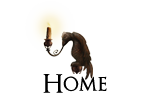Scribble City Central's thirtieth Fantabulous Friday comes from ace storyteller Saviour Pirotta. I've admired Saviour's boundless enthusiasm for all things mythological for years, and it's a delight to have him on the blog for the first time. Saviour has a way of including a tiny nugget of new information to brighten an old and familiar story which makes him one of the best retellers in this crowded field. I particularly liked his last book, The Orchard Book of Grimm's Fairy Tales, which, along with excellent versions of Rapunzel and the Princess and the Frog, has lesser known tales such as Little Mouse and Lazy Cat. Emma Chichester Clark's fabulous illustrations are, as always, a delight to behold, and I think this was an author/illustrator match made in heaven! (I'm also pleased to see that the stories are going to be available as a series of separate stand-alone books from January 2013).
Having started as a storyteller for the Commonwealth Institute, Saviour has a rich and rare treasure trove of global myths and legends to draw from. I'm not ashamed to admit that the Chinese creature he is going to tell us about is not one I'd ever heard of before - and that made me very happy, because I'm always keen to add new mythological creatures to my own store of knowledge. I'm delighted, therefore, to pass you over to Saviour to induct us all into the mystery of the elusive:
N for Nian
Hairy Chinese Beastie
SP: The Nian, also known as the Nien, is thought to be one of the most ancient monsters in the world. Its makes its homes in hard-to-reach mountain caves in faraway China, or in caverns deep at the bottom of the ocean. Since only a handful of people have looked at the terrifying Nian and lived to tell the tale, no one is quite sure what it looks like. Some say it is part ox, part lion and part unicorn. Others insist it looks like a giant lion but has pointy horns on its head. Yet others believe it is a massive hairy beast with small eyes that are always burning with rage.
Legend has it that every Spring the Nian used to creep out of its hiding place to devour livestock and people, usually children. One year it stumbled across a small village where a wise man lived. The hermit noticed several things about the Nian. It stayed away from people making too much noise, and it gave a child dressed in bright red a white berth. The monster hated noise, and was scared of the colour red!
At the next Spring festival, the people in the village were prepared for the Nian. They had festooned their houses with glowing red lanterns. Red banners flapped at every door and window. As the Nian approached, growling at the lanterns, the gate to the mayor’s house opened and a dreadful, ear-splitting noise was heard. A lion pounced out of the shadows, shaking its massive head and roaring. The Nian winced at the terrible racket. When the villagers leapt out of their houses, beating ladles and brooms on buckets and washtubs, he turned tail and fled. No one, livestock or child, was devoured by the hungry monster that year.
The lion was, of course, the wise old hermit wearing an enormous mask, but the Nian had been fooled. Ever since then, the Chinese people have welcomed the New Year with a lion dance in which they make as much noise as possible, especially by letting off firecrackers.
I have to admit that, although I tell the story of the Nian in a lot of schools, I’d never heard of it as a child. I first came across the monster while working at the Commonwealth Institute in London in the late 1980s. We used to have festivals from around the world, and Chinese New Year was one of them. It was organised by a lady from Hong Kong and it was she who first told me the story. Mind you, like with all famous tales, there are different versions in different regions including Singapore, Macau, Taiwan and Malaysia. In one the villagers actually pay a lion to scare off the Nian with its roaring. The ruse works until one year the lion gets a better offer guarding a king. Unable to find a replacement, the villages hire an actor who constructs a massive lion mask out of paper and sticks, so introducing the tradition of the lion dance in Chinese New Year.
In another, more humorous, variant of the myth, a famous monk called HongJun LaoZu, seeks out the Nian in its mountain lair.
‘Why don’t you eat the snakes that live in the valley instead of children?’ suggests HongJun, hoping the poison in the vipers would kill the Nian.HongJun peels off his clothes to reveal bright red underpants. The Nian howls in fright and hastily backs off. The monk, having discovered the monster's Achilles heel, hurries back to the village and instructs the people there to hang red lanterns at their doors and windows.
The Nian gobbles up the snake but survives.
‘Now why don’t you eat the dragon on the other side of the mountain?’ HongJun says next.
The Nian survives the dragon too, despite the fire in its throat.
‘Now little man, it’s time I ate YOU,’ it growls.
‘Just let me take my robe off,’ replies the monk. ‘You don’t want the cotton thread to snag on your teeth.’
Later on HongJun captured the Nian and used it instead of a horse. Since then, people in China have considered red a lucky colour. And every New Year they give each other lucky money tucked inside a small envelope – a red one, to scare off the Nian in case it has escaped from the brave HongJun….
When I was commissioned to write a book of Chinese stories for Hodder, I made sure I included the story of the Nian. I love the fact that no one is quite sure what it looks like, allowing me to tailor its appearance to the audience I’m reading to in schools. It’s also great fun asking children to draw their own Nians and see what animals they incorporate. We hang up a red lantern at the classroom door, of course, just in case the monster is eavesdropping on us….
SCC: Thanks so much for sharing that, Saviour. I've always wondered where the origins of the Lion dance lie, and now I know! This one tale encapsulates so many familiar facets of Chinese culture which we see in passing without really thinking about them - the love of the colour red, the lucky money envelopes, the firecrackers - that I'm surprised it's not more widely known. Has anyone here heard it before? Do tell!
You can buy Saviour's The Orchard Book of Grimm's Fairytales HERE
Saviour's new book, The Ghosts Who Danced will be published by Frances Lincoln in 2013 Next week: Award-winning author Sally Prue on how she created the terrifying O for Owlmen. See you then!






















3 comments:
That's fascinating! I've never ever heard of this creature. Thankyou Saviour and Lucy - and it's great to know more about the Lion Dance!
We have elderly Chinese neighbours and they used to have a dragon come and dance for them at New Year (their teenage children and friends, I think). Quite an astounding sight on a modern English housing estate!
Kath and Maryom, thank you. M - that must have been amazing. I've always meant to go to see the New Year celebrations in London, but never have. If I do, I'll clearly need to buy a special pair of red Nian-scaring knickers for the occasion!
Post a Comment